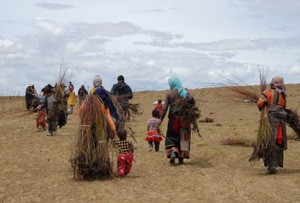
About 40 percent of the earth's land area is currently threatened by desertification. Asia, in terms of the number of people affected by desertification and drought, is the most severely affected continent.
As an example, desertification in Dzorge County is one of the major environmental crises in China. With an 8 percent annual expansion rate, the grassland in Dzorge County is gradually turning into desert. In almost 20 years, 200 lakes on this land dried up due to desertification. Shitso Lake, once home to a large and rich variety of biodiversity, is disappearing. What was once green pasture is now sand.
In the spring of 2010, the USAID-funded TSERING program responded to this urgent need through anti-desertification train-ing and activities (fencing, planting trees, and fertilizing) in co-operation with the Ruo'ergai Forestry Bureau and TSERING's partner, the Sichuan Grassland Research Institute. In achieving its success, TSERING staff worked closely with villagers to en-sure that they had greater ownership of the rehabilitation project. They received training on analyzing the reasons for desertification and developing solutions. In just a few months, by working with local communities and government, the TSERING project changed 4856 acres of desert back into grassland and provided a successful example for communities to replicate.
Villagers responded enthusiastically to the project and stated that they now feel more control over their circumstances and that there are actions they can take to stop the desertification of their land. Because of the community-felt ownership, villagers from all walks of life volunteered to help with the rehabilitation; from a 4-year-old boy to an 80-year-old grandmother.
The village community management committees will be vital for the project's sustainability and for ensuring that the grasslands are properly protected from animals and other hazards. Despite the hard work involved as part of this volunteer position, villager Gongbo Dundrub stated, "This is our own project. I'm willing to do the job."







Comment
Make a general inquiry or suggest an improvement.